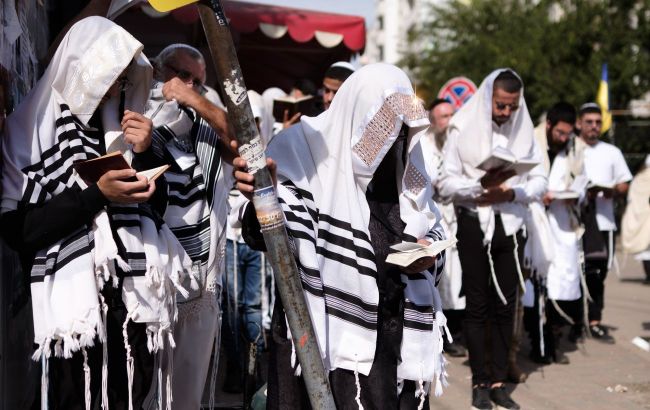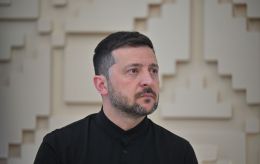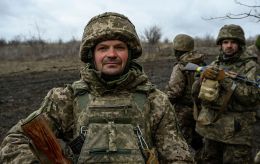Rosh Hashanah in Uman: Why small Ukrainian city draws thousands of pilgrims
 Rosh Hashanah will be celebrated on September 22-24, 2025 (photo: RBC-Ukraine)
Rosh Hashanah will be celebrated on September 22-24, 2025 (photo: RBC-Ukraine)
What the Jewish holiday of Rosh Hashanah symbolizes, how it is celebrated in Ukraine, why Hasidim from all over the world travel to Uman, and how Jews prepare for the Day of Atonement - read in an interview with RBC-Ukraine.
Key questions:
- The essence and symbols of the holiday: What Rosh Hashanah really means for Jews?
- The New Year celebration: How Jews mark Rosh Hashanah in Ukraine?
- Waiting for the Day of Atonement: What Yom Kippur is and how it is observed?
- Why have Hasidim from around the world come to Uman for the Jewish New Year?
- Can non-Jews join in the Rosh Hashanah celebrations?
From September 22 to 24, Jews will celebrate Rosh Hashanah, the holiday marking the beginning of the New Year. Traditionally, it is in mid-September to early October. According to Jewish belief, on Rosh Hashanah, God determines a person's fate for the coming year, although this decision can still be changed during the next ten days.
That is why, after the New Year begins, the Days of Repentance begin. It is a time when believers hope to receive God's blessing on the 10th day, known as the Day of Atonement. This year, Jews will welcome the year 5786.
One of the traditions during these days is a pilgrimage to Uman to the grave of Tzadik Nachman, the founder of Breslov Hasidism. For this purpose, more than 40,000 foreign pilgrims have already arrived in Ukraine.
RBC-Ukraine spoke with Albert Feldman, Director of the Ukrainian-Israeli Golda Meir Institute for Strategic Studies, artist, public figure, and Doctor of Psychology, about the traditions of celebrating Rosh Hashanah in Ukraine and its significance for Jews.
Rosh Hashanah: Essence and symbols of the Jewish holiday
– Albert, tell us about the meaning of Rosh Hashanah for Jews.
– Rosh Hashanah is one of the main Jewish holidays. It marks the beginning of the New Year and the start of a cycle of renewal. Literally, Rosh Hashanah translates as "head of the year."
From this day, we begin a new chapter in the religious and philosophical journey of life. The celebration mainly involves additional prayers, since Rosh Hashanah begins a 10-day cycle when a Jew must go through atonement, recall their sins from the past year, and arrive "purified" and thoughtful at the next holiday, Yom Kippur, known as the Day of Atonement, which comes 10 days after Rosh Hashanah.
Because Jews reflect on their sins during these days, they are also called the Days of Awe. They are neither festive nor mournful, but during this period, a person is meant to reflect more on their actions and devote more time to prayer.
The ten days following Rosh Hashanah are days of atonement and self-reflection, as Jews do not confess to rabbis or religious authorities. We make conclusions about ourselves, which encourage us to become better, live the coming year more righteously, and do more good deeds.
 Artist Albert Feldman (screenshot)
Artist Albert Feldman (screenshot)
– How is the Jewish New Year celebrated?
– This year, Rosh Hashanah will begin on September 22 around 8 p.m. At that moment, the first holiday prayer ends. It is read in all synagogues around the world almost simultaneously. After that, a festive meal with symbolic foods, visually representing the New Year, comes.
On the holiday table, there must be a pomegranate. It is both a New Year's symbol and a symbol of the 613 commandments. It is also a symbol of wealth and all the best wishes for the year ahead. Apples are also essential: their round shape represents the completeness of the year. Another important symbol is the prepared head of a fish or a ram, symbolizing beginnings, leadership, and a fresh start.
During dinner, we light two candles. There is a common misconception about lighting a menorah at the meal, but it can only be lit in the Temple (a synagogue is not considered a Temple. Jews recognize only the Temple in Jerusalem. The first was destroyed in the 6th century BCE, the second in 69 CE. According to Jewish teaching, it will be rebuilt after the coming of the Messiah –Ed.) During the holiday, we greet each other with the words "Shana Tova" ("Have a good year!")
Most Jews celebrate Rosh Hashanah in synagogues, but it can also be observed at home. The idea is that there are 10 adult men (from age 13) at the table. A collective prayer is considered valid only when 10 men who have reached the age of religious maturity are present. This is not a strict requirement, but ideally it should be so.
Another main tradition of celebrating the Jewish New Year is blowing the shofar (a Jewish ritual instrument made from a horn –Ed.). The holiday is opened by the shofar and closed on the 10th day with it, when Yom Kippur is observed. But on Rosh Hashanah itself, the shofar is not blown.
 Apples, honey, and pomegranates are symbols of Rosh Hashanah (photo: Getty Images)
Apples, honey, and pomegranates are symbols of Rosh Hashanah (photo: Getty Images)
Repentance and prayer: How Jews prepare for the Day of Atonement
– What happens on the Day of Atonement?
– Yom Kippur is a difficult day for Jews, requiring a strict fast with no eating or drinking. Exceptions are made only for those who are sick. Women and children are also expected to follow the restrictions.
On this day, one cannot wear leather shoes, wash, use perfumes, or wear jewelry, so as not to emphasize one's distinctiveness. Instead, people wear simple white clothes. The day resembles mourning, but it is not. It is the time when a Jew "purifies" themselves of sins committed over the past year.
Throughout the day in the synagogue, circular prayers are performed that bring people closer to "purification." After this, the shofar is blown, symbolizing the ending of the cleansing day.
– Are there any particular features of celebrating Rosh Hashanah in Ukraine?
– In general, all Jewish communities live almost the same way. So everything is as in Israel. The only difference here is that we also say a separate prayer for Ukraine's victory and peace.
And in the diaspora, a tradition has long existed to celebrate all holidays for two days. In the past, there were no precise technologies, and there was a chance of miscalculating the date, so it was better to include an extra day to ensure the holiday was not missed.
In Israel, Rosh Hashanah is celebrated for two days when it falls on a Saturday, since that is the most important day for Jews.
Pilgrimage to Uman: Why thousands of Hasidim go to the grave of Rabbi Nachman
– Every year, thousands of pilgrims from all over the world go to Uman to the grave of Rabbi Nachman, the founder of Breslov Hasidism. Do only followers of this movement observe the custom?
– All Jews perceive this custom differently. It is quite modern. Religious leaders go to another world, so Jews turn to their graves. There are actually many places like this in Ukraine, because all Hasidism, as a religious and mystical movement, originated here. Such graves of rabbis exist in Hadiach, Uman, and Medzhybizh. Near Kyiv in Anatevka, there is the ohel (mausoleum) of Rabbi Mordechai of Chernobyl.
Praying at a grave gives a special mystical meaning to a Jew's request. It is believed that, in this place, God's attention is more focused on the congregation; it is easier for Him to hear those who turn to Him. That's why pilgrimages are made to the graves, where collective prayers often take place.
But not only Breslov Hasidim visit Rabbi Nachman's grave; all those who believe in his holiness and teachings also come. The main meaning in this is turning to God. A person may have lived a non-Jewish life for quite a long time, but when you take a step toward God and make a vow at Rabbi Nachman's grave, you immediately become righteous.
Many seek this righteousness and strive to demonstrate it each year, which is why various representatives of Hasidic sects travel to Uman to pray. But they also visit other graves. Once again, I'd like to emphasize that Ukraine has quite many memorial sites where great rabbis are buried, and miracles occur at their graves.
On Rosh Hashanah, there is a special atmosphere there, a sense of celebration. Ukrainian Jews also make pilgrimages to these places. On Rosh Hashanah, all synagogues will be full, not only Uman's square.


 Hasidim in Uman celebrate Rosh Hashanah (photo: RBC-Ukraine)
Hasidim in Uman celebrate Rosh Hashanah (photo: RBC-Ukraine)
About Rosh Hashanah in art, the Jewish community, and the interaction of cultures
– Can non-Jews join in the celebration of Rosh Hashanah?
– I don't think it is important for other confessions, since this is a Jewish holiday. There are no bans on being present during the celebration, but no invitations are given either. Anyone who wants to learn more about Rosh ha-Shanah traditions can visit a synagogue, as they are open to the public.
There are other holidays when Jews want to share their joy with non-Jews. These are Hanukkah and also Sukkot, which comes a few days after the Day of Atonement. On these days, interaction between different religious groups is more active. But Rosh Hashanah is a more personal holiday, when Jews begin to atone for sins.
I should note that photographing during the celebration of Rosh Hashanah in a synagogue is not allowed, just as taking pictures is generally not allowed in the synagogue during any holiday.
– As an artist, do you use the symbols of Rosh Hashanah in your work?
– Since around 2019, I have been developing a series of works connected with Rosh Hashanah. Now, on the eve of the holiday, I have completed another painting. In my art, I use metaphorical images such as scales, a symbol of weighing good and bad deeds. Also present are stairs, an arch, or a door, as a symbol of transition. These are all visual meanings of the New Year. The point of these paintings is to encourage people to reflect.

.jpg)
.jpg) Paintings by Albert Feldman from the Rosh Hashanah series (photo: Albert Feldman)
Paintings by Albert Feldman from the Rosh Hashanah series (photo: Albert Feldman)
– How is the Jewish community in Ukraine developing now?
– The Jewish community has changed in recent years. Some had to leave during the pandemic, and then others left because of the full-scale war. But it is especially joyful that there are more young people who observe traditions. In particular, there are quite a lot in the Brodsky Synagogue, which I attend. Young people are actively learning traditions. There is even discussion now about opening a large Jewish university where religious studies and social sciences will be taught.
Achieving deep, genuine religiosity today is much more difficult than it was in the past. Of the 613 commandments, fewer than half can be observed now, because there is no temple where the main rituals should take place. However, some people observe all Jewish customs, such as eating kosher food, observing Shabbat, and going to synagogue. So, taking this opportunity, I wish everyone a happy Rosh Hashanah. "Shana tova u-metuka!" - "Have a good and sweet year!"

